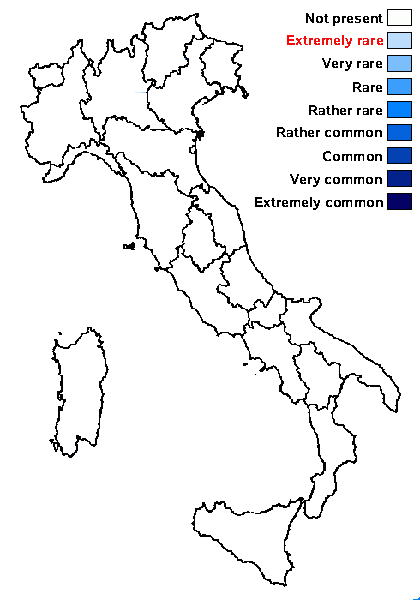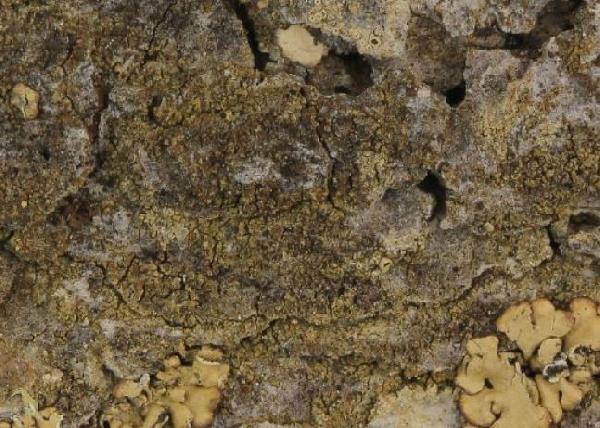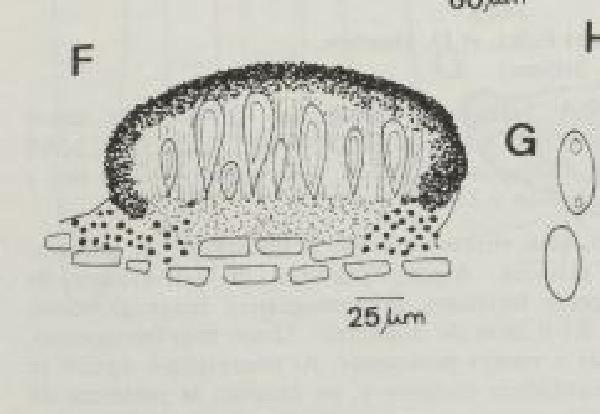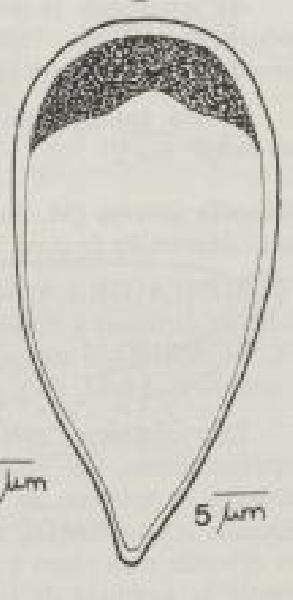Maronella laricina M. Steiner
Öst. bot. Z., 106: 441, 1959.
Synonyms: Biatorella laricina (M. Steiner) J. Erikss. & D. Hawksw.
Distribution:
Description: Thallus crustose, episubstratic, of loosely attached, c. 0.2 mm wide, greenish-grey to greenish-black, ecorticate granules which are often present only around the apothecia, without a distinct prothallus. Apothecia appearing biatorine (but the margin usually containing algae), numerous, rusty-brown, c. 0.1 mm across when dry, 0.1-0.3 mm across when moist, with an initially flat but soon turning strongly convex disc entirely covered in a red-brown pruina, and a paler, more or less persistent margin. Exciple unstratified, with orange-brown crystals, often with algae at least in basal parts; epithecium orange-brown, with crystals; hymenium colourless, 50-70 μm high; paraphyses sparingly branched and anastomosing, c. 1.5-2 μm thick, the apical slightly thickened but not capitate; hypothecium colourless or faintly yellow, of intricate hyphae, c. 20 μm high. Asci >100-spored, broadly clavate, thick-walled, surrounded by a gel not forming a distinct external cap, thickened at the apex by a tholus, without ocular chamber and axial body, the ascal gel and the dome-like tholus euamyloid, I+ blue, c. 40-50 x 18-25 μm. Ascospores 1-celled, hyaline, ellipsoid to oblong with rounded ends, (2-)3-4 x (1-)1.5-2 μm, thin-walled. Pycnidia numerous, immersed amongst the granules, with a projecting ostiolar area, the conidiogenous cells endobasidial, the conidiophores of Physcia-type (type VI of VII of Vobis 1980). Conidia ellipsoid to oblong, with rounded ends, sometimes slightly constricted in the middle, 3-4.5 x 1.8-2.2 μm. Photobiont chlorococcoid, the cells 10-20 μm wide. Spot tests: thallus K-, C-, KC-, P-; apothecial pigments K+ purple. Chemistry: thallus without lichen substances; apothecia with anthraquinones.Note: on eutrophicated bark of solitary trees (e.g. Larix, Pinus, Quercus ilex) next to manured meadows or along roadsides; apparently a rare species, so far only reported from Austria (Tyrol) and Spain, with a wide altitudinal range. For further details see Hafellner (2004). To be looked for in Italy.
Growth form: Crustose
Substrata: bark
Photobiont: green algae other than Trentepohlia
Reproductive strategy: mainly sexual

Predictive model

Detail from: Arizona State University Lichen Herbarium (ASU:Lichens) CC BY-NC 4.0 - Source: https://lichenportal.org/portal/taxa/index.php?tid=205762&taxauthid=1&clid=1492
ISOTYPE Collector: M. Steiner Date: 1958-08-25 Locality: Austria, Tyrol, Tuxer Voralpen. Wipptal, near the village Steinach-Mauern. Latitude/Longitude: 47.1 11.466667 +-3036m. WGS84 1180 m Habitat: NW-exposure; trees standing near a brooklet within meadows. Substrate: On bark of Larix decidua, especially at tree-bases.

Detail from: Arizona State University Lichen Herbarium (ASU:Lichens) CC BY-NC 4.0 - Source: https://lichenportal.org/portal/taxa/index.php?tid=205762&taxauthid=1&clid=1492
ISOTYPE Collector: M. Steiner Date: 1958-08-25 Locality: Austria, Tyrol, Tuxer Voralpen. Wipptal, near the village Steinach-Mauern. Latitude/Longitude: 47.1 11.466667 +-3036m. WGS84 1180 m Habitat: NW-exposure; trees standing near a brooklet within meadows. Substrate: On bark of Larix decidua, especially at tree-bases.
Growth form: Crustose
Substrata: bark
Photobiont: green algae other than Trentepohlia
Reproductive strategy: mainly sexual

Predictive model

Detail from: Arizona State University Lichen Herbarium (ASU:Lichens) CC BY-NC 4.0 - Source: https://lichenportal.org/portal/taxa/index.php?tid=205762&taxauthid=1&clid=1492
ISOTYPE Collector: M. Steiner Date: 1958-08-25 Locality: Austria, Tyrol, Tuxer Voralpen. Wipptal, near the village Steinach-Mauern. Latitude/Longitude: 47.1 11.466667 +-3036m. WGS84 1180 m Habitat: NW-exposure; trees standing near a brooklet within meadows. Substrate: On bark of Larix decidua, especially at tree-bases.




